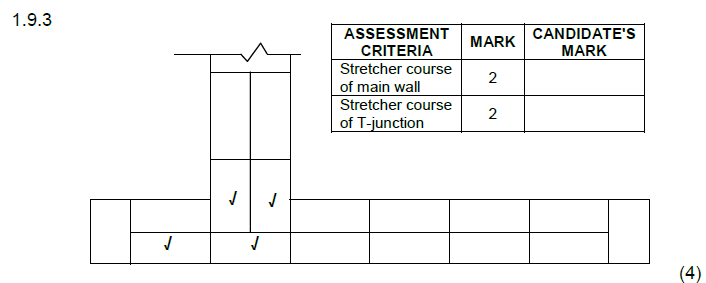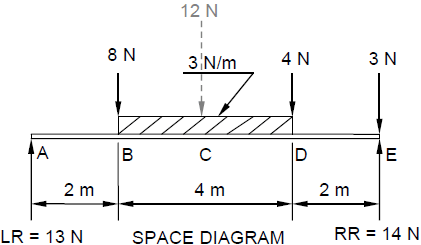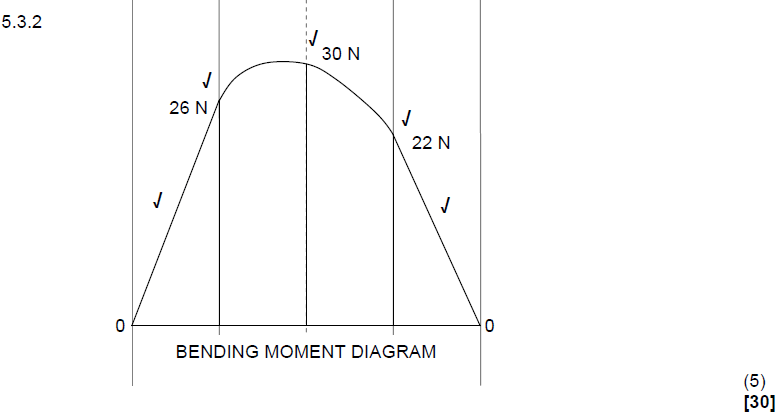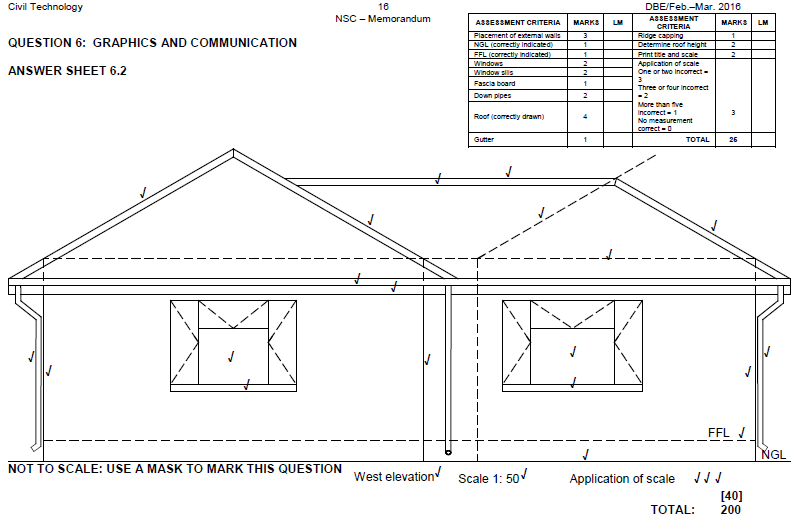CIVIL TECHNOLOGY Past Paper FEBRUARY/MARCH 2016 Memo/Memorandum - GRADE 12 NATIONAL SENIOR CERTIFICATE
Share via Whatsapp Join our WhatsApp Group Join our Telegram GroupQUESTION 1: CONSTRUCTION, SAFETY AND MATERIAL
1.1
1.1.1
- The person is using a table and chairs to reach the required height. √
- The person is not using the appropriate safety equipment. (1)
ANY ONE OF THE ABOVE OR ANY OTHER ACCEPTABLE ANSWER
1.1.2 The person can use a ladder or scaffolding to reach the required height. √ (1)
1.2
1.2.1
- When using a grinder the sparks can burn your face. √
- When using a grinder the sparks can damage your eyes.
- When painting the paint can splash in your eyes.
- When cutting or chiselling wood the wood splinters can get into your face. (1)
ANY ONE OF THE ABOVE OR ANY OTHER ACCEPTABLE ANSWER
1.2.2
- When working with cement you will inhale the dust and it can cause lung problems. √
- When sawing/sanding wood you will inhale the dust. (1)
ANY ONE OF THE ABOVE OR ANY OTHER ACCEPTABLE ANSWER
1.2.3
- You can get an injury when heavy objects fall on your feet. √
- You can get an injury when stepping onto nails, screws or any other sharp object.
- You won't have the insulation protection when coming in contact with electricity. (1)
ANY ONE OF THE ABOVE OR ANY OTHER ACCEPTABLE ANSWER
1.3
- Ensure that workers maintain a safe distance from material that is moving overhead √
- Seek help to move material that is too heavy to handle alone. √
- Ensure that there are enough workmen to carry heavy loads. √
- The material must be secured firmly.
- When material is being moved by a hoist a qualified person must operate the hoist. (3)
ANY THREE OF THE ABOVE OR ANY OTHER ACCEPTABLE ANSWER
1.4
1.5
1.5.1 Channel iron √ (1)
1.5.2
- The steel profile is grey √
- Prone to rust
- A good conductor of heat
- Malleable
- Doesn't bend easily
- Welds well
- Can easily be joined (1)
ANY ONE OF THE ABOVE OR ANY OTHER ACCEPTABLE ANSWER
1.6
- Stone is used to add bulk to the concrete. √
- Stone makes the mix more economical. √
- Using stone in concrete reduces the paste content and therefore makes the concrete more stable. √
- The quantity of stone also determines the strength of the concrete.
- Stone also reduces shrinkage and deformations. (3)
ANY THREE OF THE ABOVE OR ANY OTHER ACCEPTABLE ANSWER
1.7
- Beneath concrete floors. √
- Under window sills. √
- At roofs/under roof covering. √
- Under the wall of the super structure. (3)
ANY THREE OF THE ABOVE OR ANY OTHER ACCEPTABLE ANSWER
1.8 Damp proof course is used to prevent damp/moisture to enter a building. √ (1)
1.9
1.9.1 Stretcher bond (1)
1.9.2
1.10
- Clay/Slate tiles √
- Galvanised corrugated iron sheets √
- Galvanised IBR roof sheeting
- Thatch roof
- Cement fibre sheet (2)
ANY TWO OF THE ABOVE OR ANY OTHER ACCEPTABLE ANSWER
1.11
- Timber frames need regular maintenance. √
- Timber is expensive since imported hardwood is scarce. √
- Timber cannot be effectively burglar-proofed.
- Timber is prone to attacks by insects and fungi.
- Timber is not fire resistant. (2)
ANY TWO OF THE ABOVE OR ANY OTHER ACCEPTABLE ANSWER
QUESTION 2: ADVANCED CONSTRUCTION AND EQUIPMENT
2.1
2.1.1 Portable electric planer √ (1)
2.1.2 This machine is mainly used to plane:
- edges. √
- ends. √
- bevels.
- rebates.
- chamfers. (2)
ANY TWO OF THE ABOVE OR ANY OTHER ACCEPTABLE ANSWER
2.1.3
- It can remove more than 2 mm of wood at once.√
- It planes more accurately.
- It planes much faster than a hand plane. (1)
ANY ONE OF THE ABOVE OR ANY OTHER ACCEPTABLE ANSWER
2.1.4 By using a generator on site this machine can still be used. √ (1)
2.2
2.2.1
- Measuring of heights √
- Measuring of distances √
- Measuring of angles (2)
2.2.2
- The telescopic level/dumpy level √
- The tripod √
- Telescopic staff √ (3)
2.3
√ (1)
ANY ONE OF THE ABOVE
2.4 When you build cavity walls. √ (1)
2.5
2.5.1 Pre-stressed concrete ribs/Concrete ribs/Ribs. √ (1)
2.5.2
- Ribbed bar √
- Twisted rib bar
- Square twisted bar
- Round bar (1)
ANY ONE OF THE ABOVE OR ANY OTHER ACCEPTABLE ANSWER
2.5.3
- It acts as additional reinforcement. √
- The steel mesh can be tied to the triangular reinforcing of the rib with binding wire.
- Ensure effective binding between concrete and rib. (1)
ANY ONE OF THE ABOVE OR ANY OTHER ACCEPTABLE ANSWER
2.5.4 At rib and block floors. √ (1)
2.5.5
- Spraying with water
- A patent sealer can be used
- Concrete can be covered with wet sand
- Concrete can be covered with hessian
- Concrete can be covered with canvas
- Concrete can be covered with other protective covering (1)
ANY ONE OF THE ABOVE OR ANY OTHER ACCEPTABLE ANSWER
2.5.6
- Flathead prop √
- Drop head prop
- Multi prop
- Prop (1)
ANY ONE OF THE ABOVE OR ANY OTHER ACCEPTABLE ANSWER
2.6
- Shutter boards should be cleaned after use. √
- All rests/residue of concrete should be removed. √
- All holes should be plugged.
- Release agents or emulsion oil should be applied to the shutter boards. (2)
ANY TWO OF THE ABOVE OR ANY OTHER ACCEPTABLE ANSWER
2.7
- Shuttering (formwork) should be strong enough to carry the load of the wet concrete. √
- It should be able to bear the mass of people and equipment working on it. √
- Formwork material should be made of a material, which can easily be repaired in situ. √
- It should be constructed in such a manner that it can be easily removed and erected.
- It must be assembled accurately.
- It must be sealed off to prevent unnecessary loss of concrete, which may lead to honeycombing.
- It must be clean from dirt such as sawdust and excessive release agent. (3)
ANY THREE OF THE ABOVE OR ANY OTHER ACCEPTABLE ANSWER
2.8
2.8.1
- A – Shear bar √
- B – Stirrup/binders √
- C – Anchor bar √
- D – Main bar √ (4)
2.8.2
Spacers cover depth blocks/cover depth stand, are used to keep the bars away from shuttering boards (formwork). √ (1)
2.9
- Soleplates are used to create a level surface onto which the scaffold can be erected. √
- It is used to prevent the scaffolding from sinking into the ground.
- It spreads the load of the scaffold, materials and workmen evenly onto the ground. (1)
ANY ONE OF THE ABOVE OR ANY OTHER ACCEPTABLE ANSWER
2.10
2.10.1 The weep-hole must be inserted above the horizontal damp-proof course of the external part of the wall. √ (1)
2.10.2 Allow water penetrating the outside wall to drain out of the building. √ (1)
2.10.3
- The cavity ensures that no water will penetrate the inner wall. √
- The cavity provides insulation against heat. √
- The cavity provides insulation against cold.
- The cavity provides insulation against sound. (2)
ANY TWO OF THE ABOVE OR ANY OTHER ACCEPTABLE ANSWER
2.10.4
Weak concrete mixture √ (1)
2.10.5
110 + 50 + 110 √ = 270 √ (2)
2.11 Waterproof gypsum board/fibre cement board/marine plywood √ (1)
2.12 Normal/Strip foundations are used. √ (1)
2.13 Centre √ (1)
2.14 Intrados √ (1)
[40]
QUESTION 3: CIVIL SERVICES
3.1
3.1.1 B √ (1)
3.1.2 E √ (1)
3.1.3 D √ (1)
3.1.4 C √ (1)
3.1.5 A √ (1)
3.2
- PVC pipe √
- Copper pipe √
- Galvanized pipe √ (3)
3.3
3.3.1 It is to provide water to the tap. √ (1)
3.3.2 Cap B is removable to provide access to the inside of the pipe. √ (1)
3.3.3 Waste water pipe/PVC pipe/Galvanised pipe √ (1)
3.3.4 40 mm/50 mm √ (1)
3.3.5 It is used to anchor the pipe to the wall. √ (1)
3.3.6 It is used to guide the wastewater directly into the gully. √ (1)
3.3.7 100 mm interior/110 mm exterior √ (1)
3.3.8
- The purpose is to form a water seal/water trap/water lock. √
- To prevent bad odours and gasses from the sewer entering back into the building. (1)
ANY ONE OF THE ABOVE OR ANY OTHER ACCEPTABLE ANSWER
3.3.9 P – trap √ (1)
3.4
3.4.1 Wash tub √ (1)
3.4.2 Sewer line/drain pipes √ (1)
3.4.3 Safety valve √ (1)
3.4.4 Storm water drain pipes √ (1)
3.5
- It contains chemicals that are poisonous to the bacteria in the tank. √
- The tank will fill up quickly and block the system. √ (2)
3.6
- A – Stopcock √ (1)
- B – Pressure control valve √ (1)
- C – Vacuum breaker √ (1)
- D – Drain cock/Cold water inlet √ (1)
- E – Drip tray √ (1)
- F – Safety valve/Hot water outlet √ (1)
- G – Hot water cylinder/Geyser √ (1)
[30]
QUESTION 4: QUANTITIES, MATERIALS AND JOINING
4.1
4.1.1 1 130 mm √ (1)
4.1.2 150 mm √ (1)
4.1.3 114 mm √ (1)
4.1.4 Window stile √ (1)
4.1.5 44 mm √ (1)
4.1.6 54 mm √ (1)
4.1.7 4 √ (1)
4.2
4.2.1 B √ (1)
4.2.2 A √ (1)
4.2.3 D √ (1)
4.2.4 C √ (1)
4.2.5 D √ (1)
4.3
- Galvanising hoop iron is used to tie down or attach roof trusses to the brickwork. √
- To fix wall plates to walls.
- For cross bracing of roof trusses.
- To secure timber frames to brick work.
- To join existing brickwork to new brickwork (1)
ANY ONE OF THE ABOVE OR ANY OTHER ACCEPTABLE ANSWER
4.4 Steel nails √ (1)
4.5
- Rawl bolts √
- Chemical fasteners in conjunction with threaded rods and nuts
- Sleeve anchors can be used. (1)
ANY ONE OF THE ABOVE OR ANY OTHER ACCEPTABLE ANSWER
4.6
QUESTION 5: APPLIED MECHANICS
5.1
5.1.1 90 mm x 30 mm = 2 700 mm² √ (1)
5.1.2 60 mm x 60 mm = 3 600 mm² OR 3 150 mm² √ (1)
5.1.3 15 mm x 30 mm = 450 mm² √ (1)
5.1.4 2 700 mm + 3 600 mm – 450 mm = 5 850 mm² √ (1)
5.1.5 55 mm √ (1)
5.1.6 45 mm √ (1)
5.1.7 40 mm √ (1)
5.1.8 45 mm √ (1)
5.2
| MEMBER | NATURE | MAGNITUDE |
| AE | Strut √ | 95,2 N √ |
| DE | Tie √ | 47,6 N √ |
NOT ACCORDING TO SCALENOT ACCORDING TO SCALE
USE A MASK TO MARK THIS QUESTION
Tolerance of 1 N to either side
ANSWER SHEET 6.1
| NO. | QUESTIONS | ANSWERS | MARKS |
| 1 | Identify the type of eave construction used in the drawing. | Open/exposed eave | 1 |
| 2 | State the minimum pitch (slope) of number 1. | 10° | 1 |
| 3 | State the standard dimension of number 2. | 114 mm x 38 mm | 1 |
| 4 | Draw the drawing symbol for number 3. |  | 1 |
| 5 | Name the colour coding for number 3. | Red | 1 |
| 6 | Explain the purpose of number 4. | It is used to spread the load of the roof evenly onto the supporting walls of the building. | 1 |
| 7 | State the standard dimension of number 5. | 50 mm x 76 mm | 1 |
| 8 | State the centre-to-centre spacing for number 5. | 900 mm to 1 200 mm | 1 |
| 9 | As a draughtsman, recommend a suitable roof truss for a building with a span of 4 metres. | King post roof truss, SA (Howe) roof truss, W-roof truss, Couple roof | 1 |
| 10 | State the width of the wall indicated by number 6. | 110 mm | 1 |
| 11 | Draw the top view of the layout of a gable roof for the proposed building indicated in the answer column. |  | 5 |
| Total | 16 |
QUESTION 6: GRAPHICS AND COMMUNICATION
ANSWER SHEET 6.2












